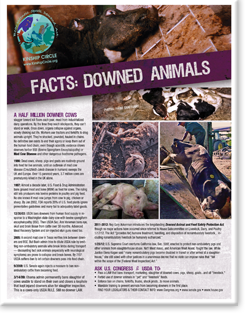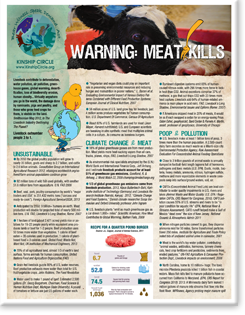
“Their eyes look like they are popping out,” a former worker at IBP-Wallula Slaughterhouse stated. “I feel bad when I have to do my job on them.”
|
 |
Dawn arrives as mist. Signs of renewal abound as my husband and I haul Kinship Circle materials across the grounds of Earth Day. Booths beckon us to Go Green! Recycle! Conserve! Meat-on-a-stick!
MEAT-ON-A-STICK? I stumble over the paradox even as grilled burgers, dogs and sausages reek of confined animals, wasted resources, pollution. The incongruity is stunning. I mentally assign my next column to these recyclers and fuel-efficient drivers — who still eat meat. Consider the contradiction…
Imagine world hunger through the eyes of a starving child. With heartfelt proximity, she stares from magazine ads that ask for our empathy and money. But even as she goes to bed hungry, affluent nations feed cattle 16 pounds of grain to generate a single pound of beef.
A 10% reduction in U.S. meat output alone could free enough grain to nourish 60 million people, Harvard nutritionist Jean Mayer contends. Livestock outnumber humans by 3 to 1.
“Within as little as 10 years, the world will be faced with a choice: arable farming either continues to feed the world's animals or it continues to feed the world's people. It cannot do both,” writes Georges Monbiot, an omnivore, for the British newspaper The Guardian. “It now seems plain that a [vegan diet] is the only ethical response to what is arguably the world's most urgent social justice issue. We stuff ourselves, and the poor get stuffed.”
Meat production taxes water, forests, land and energy stores. “Within 150 years the planet's riches could be exhausted,” Living Planet Report 2002 predicts. “By 2050 two Earths would be needed to cope with resource demands.”
More than 1/3 of U.S. raw materials and fossil fuels go to animal agriculture. Consider the hamburger to veggie burger ratio: One patty usurps enough fuel to travel 20 miles, claims John Robbins in The Food Revolution. Conversely, plant-based proteins require eight times less fossil-fuel energy.
Cornell ecologist David Pimentel says the standard meat eater exhausts the equivalent of a gallon of gas per day — double the amount needed to cultivate a vegan diet. Another startling truth comes from Gidon Eshel, a Bard Center geophysicist, and Pamela A. Martin, a University of Chicago assistant professor of geophysics: If Americans give up meat in just 20% of meals, it's as if each swaps a sedan for a mega-efficient Prius.
A single burger also represents a deficit of five times its weight in topsoil. Meat factories ravage soil, particularly rainforests at a rate of 125,000 sq. miles per year. One rainforest-produced patty clears 55 sq. feet of land. We've run out of room to farm animals for food. But that does't diminish our taste for meat. The industry seizes more Amazon rainforest, regularly razing segments of 20-30 plant species, 100 insect species, and dozens of bird, mammal and reptile species.
Grain-fed livestock guzzle 80% of U.S. water reserves. Chicken factories alone can drain 100,000 gallons a day and beef production consumes more water than the total expended on U.S. fruit and vegetable crops. “You'd save more water by not eating a pound of California beef than you would by not showering for an entire year,” Robbins asserts. A pound of flesh requires 2,500 gallons of water to go from live animal to grocer's freezer. A pound of wheat uses a comparatively low 25 gallons of water.
If starving kids and a drained earth don't get to you, the poop just might. Every year enormous lagoons stockpile close to 3 trillion pounds of the stinky stuff. These cesspools seep into ground water and local aquifers. Farmers fertilize fields with a manure mist that scatters even more toxins. A U.S. Senate Committee on Agriculture, Nutrition and Forestry report found that farmed animals expel 130 times as much fecal matter as the entire human population.
Waste runoffs, the chief source of toxic microbes in coastal waters, have killed millions of fish and spread harmful pathogens to people. An EPA study reveals that U.S. farms cause 70% of river pollution and 49% of lake pollution.
A 2003 New York Times article chronicled residents in rural Aulding, Ohio who suffered chronic headaches, diarrhea, vomiting, nosebleeds, earaches, lung burns, seizures, memory loss, vertigo and other neurological complications. One family's 14th doctor finally sourced the town's reliance on inhalers, nebulizers and oxygen tanks to noxious gases emitted from the football-field length wastepools of a nearby industrial hog farm.
According to University of Southern California professor Dr. Kaye H. Kilburn, “the coincidence of people with a pattern of impairment and exposure to hydrogen sulfide arising from lagoons where hog manure is stored and then sprayed on fields or into the air” renders the link “practically undeniable.”
U.S. Dept. of Agriculture is led by meat-dairy executives and lobbyists, with scant regard for animal welfare. Animals are processed assembly-line style in artificial settings that call for antibiotics, chemicals, hormones and steroids. In 2007, USDA's Foreign Agricultural Service counted nearly 63 billion land animals butchered for food internationally. In America, some 10 billion land animals, plus about 17 billion fish, die for human consumption each year.
Hog farms warehouse 600-pound sows in gestation stalls for a motionless life atop cement and excrement. At veal factories tiny calves are chained by the neck inside 2-feet crates, unable to flex their legs or lie down with ease. Egg-laying hens share their brief lives with 8 to 9 other birds inside wire cages no larger than a folded newspaper. Many are starved in 10-14 day cycles (forced molting) to boost egg production. Meat-yielding chickens and turkeys are overcrowded inside dark grower houses where workers amputate part of each bird's beak to subdue fighting.
Other standard practices include slicing off of animals' tails, toes or horns, without anesthesia. In a Los Angeles Times cover story, Killing Them Softly, reporter Stephanie Simon offers a rare glimpse inside the killing room. Slung upside down by their hooves, presumably dead pigs wiggle and sway as a conveyer belt moves them to the gutting team. “Now and then, one would rear back and strain to right itself,” Simon says. “No one made much fuss. The animals would be sliced for sausage within minutes. If a few left the kill floor still aware, still kicking — well that was how the slaughterhouses operated.”
|
Veteran inspector Temple Grandin audits slaughterhouses to determine if they adhere to federal humane slaughter laws. Cows and pigs are commonly stunned with captive bolt guns that shoot a retractable metal rod into their brains. Grandin observed defective bolt guns and incompetent or insufficient staff at two-thirds of the processing plants she surveyed.
“Their eyes look like they are popping out,” a former worker at IBP-Wallula Slaughterhouse said during a cruelty investigation of the Washington plant. “I feel bad when I have to do my job on them.” Pigs who awaken after stunned are boiled alive in hot-water tanks. Grandin recorded inept stunning at 1/3 of the hog plants examined.
Guilt-free meat and egg shoppers swear by the “Animal Care Certified” label. USDA criteria for organic labeling requires open-air access for animals. Yet the USDA already waives this standard for poultry and egg factories. United Egg Producers (UEP) get the organic green light if they cage hens with 67 sq. inches of space per bird, rather than the typical 48 sq. inches.
They may still force molt, debeak and smother birds at rendering plants and in landfills. Some poultry plants that claim to free-range their meat-producing birds do little more than carve a hole in the warehouse wall.
The massive depletion of Earth's resources, along with animals suffering by the billions, did not occur overnight. We can begin to unravel the mess through reduction in factory farms and the relentless breeding of animals for food. Eating lower on the food chain is the logical path toward a rejuvenated planet.
|


|
|

